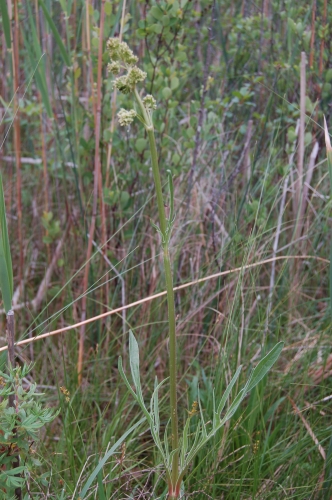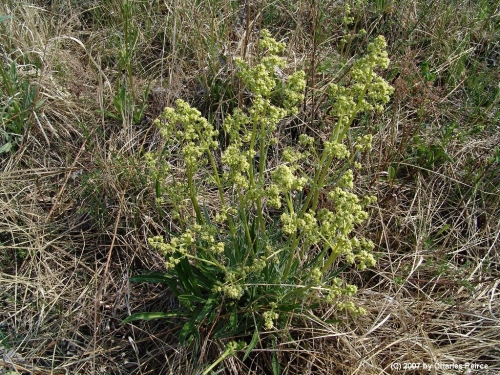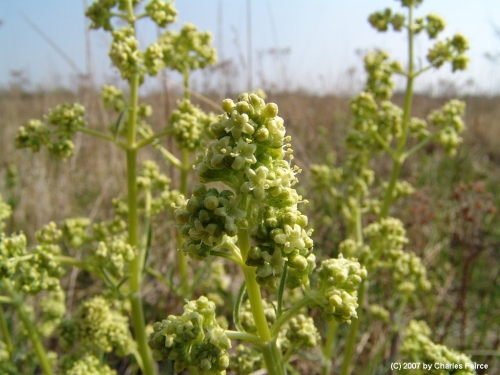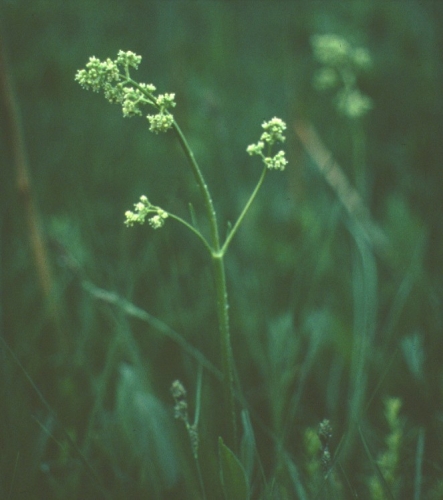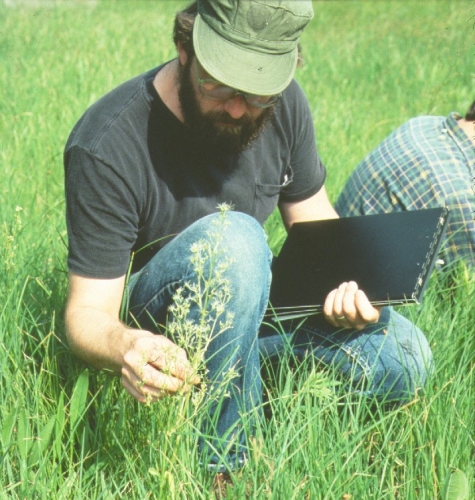Plants and Animals
Valeriana edulis var. ciliata Edible valerian
Key Characteristics
Low forb of calcareous fens; succulent stems arise from a rosette, with leaf margins that very densely ciliate; inflorescence white, becoming longer than broad.
Status and Rank
US Status: No Status/Not Listed
State Status: T - Threatened (legally protected)
Global Rank: G5T3
State Rank: S2 - Imperiled
Occurrences
| County | Number of Occurrences | Year Last Observed |
|---|---|---|
| Berrien | 4 | 2013 |
| Cass | 5 | 2009 |
| Hillsdale | 2 | 1999 |
| Jackson | 1 | 1954 |
| Kalamazoo | 1 | 1975 |
| Lenawee | 6 | 2014 |
| Livingston | 2 | 1949 |
| Oakland | 2 | 1947 |
| Van Buren | 3 | 2013 |
| Washtenaw | 6 | 2012 |
Information is summarized from MNFI's database of rare species and community occurrences. Data may not reflect true distribution since much of the state has not been thoroughly surveyed.
Habitat
Edible valerian occurs in alkaline fens in southern Lower Michigan.
Natural Community Types
For each species, lists of natural communities were derived from review of the nearly 6,500 element occurrences in the MNFI database, in addition to herbarium label data for some taxa. In most cases, at least one specimen record exists for each listed natural community. For certain taxa, especially poorly collected or extirpated species of prairie and savanna habitats, natural community lists were derived from inferences from collection sites and habitat preferences in immediately adjacent states (particularly Indiana and Illinois). Natural communities are not listed for those species documented only from altered or ruderal habitats in Michigan, especially for taxa that occur in a variety of habitats outside of the state.
Natural communities are not listed in order of frequency of occurrence, but are rather derived from the full set of natural communities, organized by Ecological Group. In many cases, the general habitat descriptions should provide greater clarity and direction to the surveyor. In future versions of the Rare Species Explorer, we hope to incorporate natural community fidelity ranks for each taxon.
Associated Plants
Trees: Larix laricina (tamarack).
Shrubs: Betula pumila (bog birch), Cornus spp. (dogwoods), Dasiphora fruticosa (shrubby cinquefoil), Rhamnus alnifolia (alder-leaved buckthorn), Salix spp. (willows), and Spiraea alba (meadowsweet).
Ground layer: Andropogon gerardii (big bluestem), Arnoglossum plantagineum (prairie Indian-plantain), Calamagrostis canadensis (blue-joint grass), Campanula aparinoides (marsh bellflower), Carex interior (inland sedge), C. sterilis (sterile sedge), C. stricta (tussock sedge), C. tetanica (rigid sedge), Cicuta maculata (water hemlock), Cladium mariscoides (twig-rush), Eleocharis elliptica (golden-seeded spike-rush), Eupatorium perfoliatum (common boneset), Eutrochium maculatum (Joe-pye-weed), Juncus spp. (rushes), Lysimachia quadriflora (whorled loosestrife), Parnassia glauca (grass-of-parnassus), Pilea fontana (bog clearweed), Platanthera leucophaea (prairie fringed-orchid), Pycnanthemum virginianum (Virginia mountain mint), Rudbeckia hirta (black-eyed Susan), Schizachyrium scoparium (little bluestem), Schoenoplectus acutus (hardstem bulrush), S. pungens (three-square), Solidago ohioensis (Ohio goldenrod), S. riddellii (Riddell's goldenrod), Sorghastrum nutans (Indian grass), Sporobolus heterolepis (prairie dropseed), and Thelypteris palustris (marsh fern).
Management Recommendations
This species requires protection of the hydrology, groundwater source, and natural disturbance regime. This species benefits from fen management that includes prescribed fire and brush removal, which maintains open habitat and reduces competing woody vegetation. Control invasive species, especially glossy buckthorn and purple loosestrife. Protect habitat from being drained and developed.
Survey Methods
Random meander search covers areas that appear likely to have rare taxa, based on habitat and the judgement of the investigator.
-
Meander search
-
Survey Period: From first week of May to fourth week of June
-
References
Survey References
- Elzinga, C.L., D.W. Salzer, and J.W. Willoughby. 1998. Measuring and Monitoring Plant Populations. The Nature Conservancy and Bureau of Land Management, Denver. BLM Technical Reference 1730-1. 477pp.
- Goff, G.F., G.A. Dawson, and J.J. Rochow. 1982. Site examination for Threatened and Endangered plant species. Environmental Management 6(4): 307-316
- Nelson, J.R. 1984. Rare Plant Field Survey Guidelines. In: J.P. Smith and R. York. Inventory of rare and endangered vascular plants of California. 3rd Ed. California Native Plant Society, Berkeley. 174pp.
- Nelson, J.R. 1986. Rare Plant Surveys: Techniques For Impact Assessment. Natural Areas Journal 5(3):18-30.
- Nelson, J.R. 1987. Rare Plant Surveys: Techniques for Impact Assessment. In: Conservation and management of rare and endangered plants. Ed. T.S. Elias. California Native Plant Society, Sacramento. 8pp.
Technical References
- Coffin, B. and L. Pfannmuller, eds. 1988. Minnesota's Endangered Flora and Fauna. University of Minnesota Press, Minneapolis. 473pp.
- Cooperrider, T.S. 1995. The Dicotyledonae of Ohio Part 2. Linaceae through Campanulaceae. Ohio State University Press, Columbus. 656pp.
- Deam, C. C. 1940. Flora of Indiana. Department of Conservation, Indianapolis. 1236pp.
- Gleason, H. A., and A. Cronquist. 1991. Manual of Vascular Plants of Northeastern United States and Adjacent Canada. Second edition. The New York Botanical Garden, Bronx. 910pp.
- Gray, A. 1950. Gray's Manual of Botany; eighth ed. Van Nostrand Reinghold, New York. 1632pp.
- Holmgren, N.H. 1998. Illustrated Companion to Gleason and Cronquist's Manual. Illustrations of the vascular plants of Northeastern United States and adjacent Canada. New York Botanical Garden, Bronx. 937pp.
- Mohlenbrock, R.H. 1986. Guide to the Vascular Flora of Illinois. Southern Illinois University Press, Carbondale. 507pp.
- Swink, F. and G. Wilhelm. 1994. Plants of the Chicago Region, 4th ed. Indiana Academy of Science, Indianapolis. 921pp.
- Voss, E.G. 1996. Michigan Flora. Part III. Dicots (Pyrolaceae-Compositae). Bulletin of the Cranbrook Institute of Science and University of Michigan Herbarium. 622pp.


